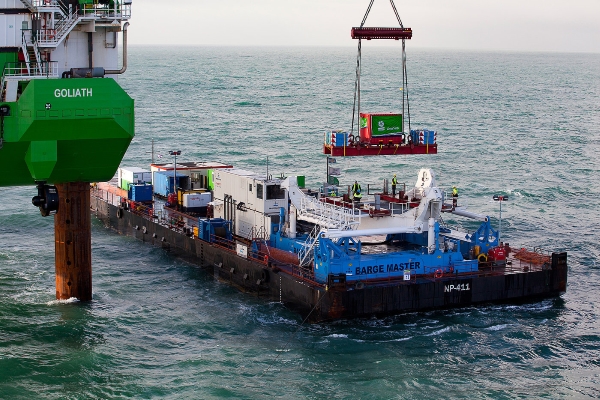DEME and Barge Master partner up for US offshore windfarm installations

Credit: Barge Master
DEME Offshore US has entered into a five-year agreement with Barge Master to develop
motion-compensation platforms to support the Vineyard Wind 1 project, off the US east
coast.
To maintain compliance with the US’ Jones Act legislation, DEME cannot specifically load
the turbines and carry them to the installation site – the way a wind turbine installation vessel
(WTIV) would normally operate. Instead, it has partnered with Foss Maritime for the
transport of the turbines off shore, using specially-developed feeder barges built in US
shipyards and crewed by US personnel, to where they will be installed using a DEME wind
WTIV.
The turbines will be lifted from the Foss vessel using special motion-compensation
platforms. Barge Master, will provide this lifting technology as a manufacturer of motion-
compensation systems including platforms, gangways and cranes. The motion-
compensation system works by measuring vessel motions and actively compensates one
translation (heave) and two rotations (roll and pitch) with three hydraulic cylinders. Barge
Master says the technology can be applied to compensate for “any motion of a vessel and
ensures that the platform is kept in an earth fixed steady position”.
“This fully Jones Act compliant solution, based on using US- flagged and US-owned tugs
and barges, again demonstrates our commitment to build and support the US offshore wind
industry and to create jobs for (unionised) American mariners,” said President of DEME
Offshore US, Sidney Florey. “Uniquely, this technology turns existing barges into a high-
tech, smart feeder concept, resulting in a competitive advantage for DEME Offshore and its
partners. This solution also leads to sharp pricing and guaranteed availability for the offshore
wind developers, our clients.”
Two of these smart feeder barges are set to be in operation by spring 2023, DEME, Foss
Maritime and Barge Master confirmed.
Barge Master Director, Martijn Koppert, said: “We are providing the most competitive feeder
solution in the market by utilising proven technology. By combining our motion compensated
feeder platforms with existing US maritime equipment and DEME Offshore’s jack-up vessels,
the CAPEX and OPEX are kept low when compared to other concepts. We are confident this
feedering solution is perfect for the US offshore wind market today, as well as for other
large-scale wind farms in the future.”
The Vineyard 1 development, around 56km south of the Massachusetts coastline, is one of
the first few offshore wind projects in the United States, which is liable to be the start of an
explosion in offshore wind activity given North America’s terawatts of wind energy potential.
The Biden administration is targeting 30GW by 2030, and investigations are underway into
how the US could install wind capacity off its west coast, where the continental shelf drops
off sharply, precluding conventional offshore turbine installations.
The US’ total pipeline of offshore wind installations stands at 46GW. This does not yet make
it a world leader, however, as the UK’s pipeline currently stands at 86GW, and China is a
close second at 75GW.
While the advice given in this editorial content has been developed using the best information available, it is intended purely as guidance to be used at the user’s own risk. No responsibility is accepted by CEDA or by the Intent Communications Ltd or by any person, firm, corporation or organisation who or which has been in any way concerned with the furnishing of information or data, the compilation, publication or any translation, supply or sale of this Guidance for the accuracy of any information or advice given herein or for any omission herefrom or from any consequences whatsoever resulting directly or indirectly from compliance with or adoption of guidance contained therein even if caused by a failure to exercise reasonable care.